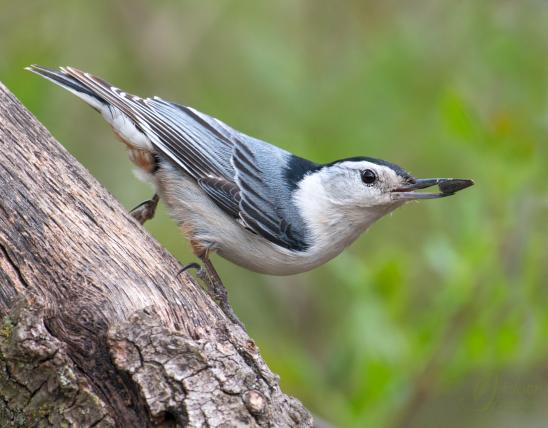
Head and upperparts of the adult yellow-bellied sapsucker are black and white with a red crown. White band on the middle part of the wing and a white rump. Male has a red throat; female has a white throat. Underparts whitish with a yellow wash on the belly. Juvenile has a brownish head, neck, and throat. Voice a variety of squealing calls, often not loud: a descending churr, mews, and weep-weep. A irregular tap-tap, tap-tap-tap, tap, tap-tap-tap drumming pattern, like Morse Code, is characteristic.
Similar species: In Missouri, the two most common woodpeckers with which it might be confused are the downy and hairy woodpeckers. Though also rather small, they both have a black crown, solid white undersides, and small white spots on their wings instead of a broad white band.
Length: 8½ inches (tip of bill to tip of tail).

Statewide.
Habitat and Conservation
The yellow-bellied sapsucker forages on trees in forests, orchards, and parks. The mottled pattern on their backs helps them blend in with the tree trunks upon which they perch, including the wet, darkened portions of bark. Because of the damage they can inflict on trees and their habit of eating fruit, they were formerly viewed as “injurious” and shot. They are protected today, and few view them as pests. Populations appear to be stable.
Food
Forages on trees for insects, fruits, nuts, and berries. Yellow-bellied sapsuckers are woodpeckers that drill small, often evenly and closely spaced holes in trees in order to extract the sweet sap. In the process of drilling, sapsuckers eat the inner bark, drink the sap, and catch insects such as ants that are attracted to the sap.
Status
Uncommon migrant; uncommon (south) and rare (north) winter resident. Rare in winter south of the Missouri River, and usually absent in northern Missouri. In the past, it was probably a rare breeder along the Mississippi River north of St. Louis.
Life Cycle
This is the most migratory woodpecker in eastern North America, with the breeding range in Canada, the Great Lakes, and New England, and wintering range extending as far south as Panama. Missouri is at the northern limit of the wintering range. Like other woodpeckers, they are cavity nesters. There are 4-6 eggs per clutch, and incubation lasts 10-13 days. Young fledge after 25-30 days.
Human Connections
When sapsuckers drill too many holes in any one tree, they can girdle it, cutting off the flow of sap to the branches, possibly killing the tree. This is more of a problem in northern states, but when it happens in orchards and other trees important to humans, it can be a problem.
Ecosystem Connections
Although sapsuckers defend their sap wells, several other animals, such as squirrels, other birds, and insects, take advantage of the sap pooled in the holes. Hummingbirds may find their first meals of the season at sapsucker holes, which are usually available before flower nectar.






About 350 species of birds are likely to be seen in Missouri, though nearly 400 have been recorded within our borders. Most people know a bird when they see one — it has feathers, wings, and a bill. Birds are warm-blooded, and most species can fly. Many migrate hundreds or thousands of miles. Birds lay hard-shelled eggs (often in a nest), and the parents care for the young. Many communicate with songs and calls.






























